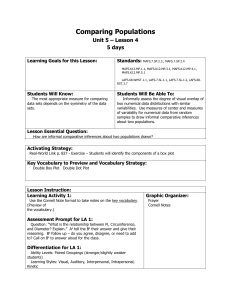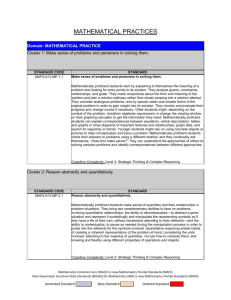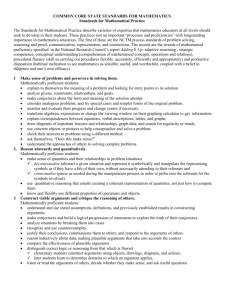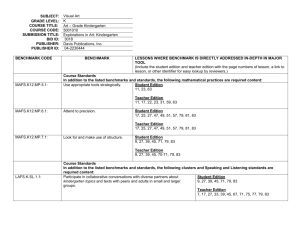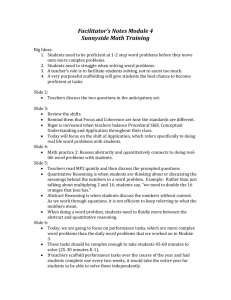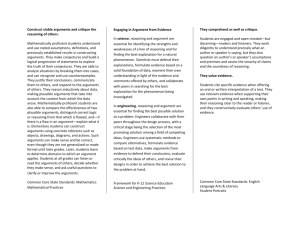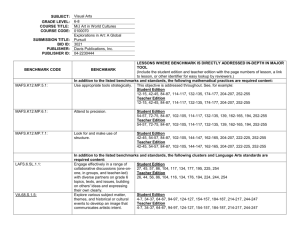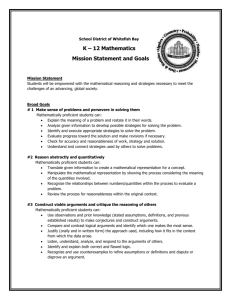Content Complexity. Level 3: Strategic Thinking & Complex Reasoning
advertisement
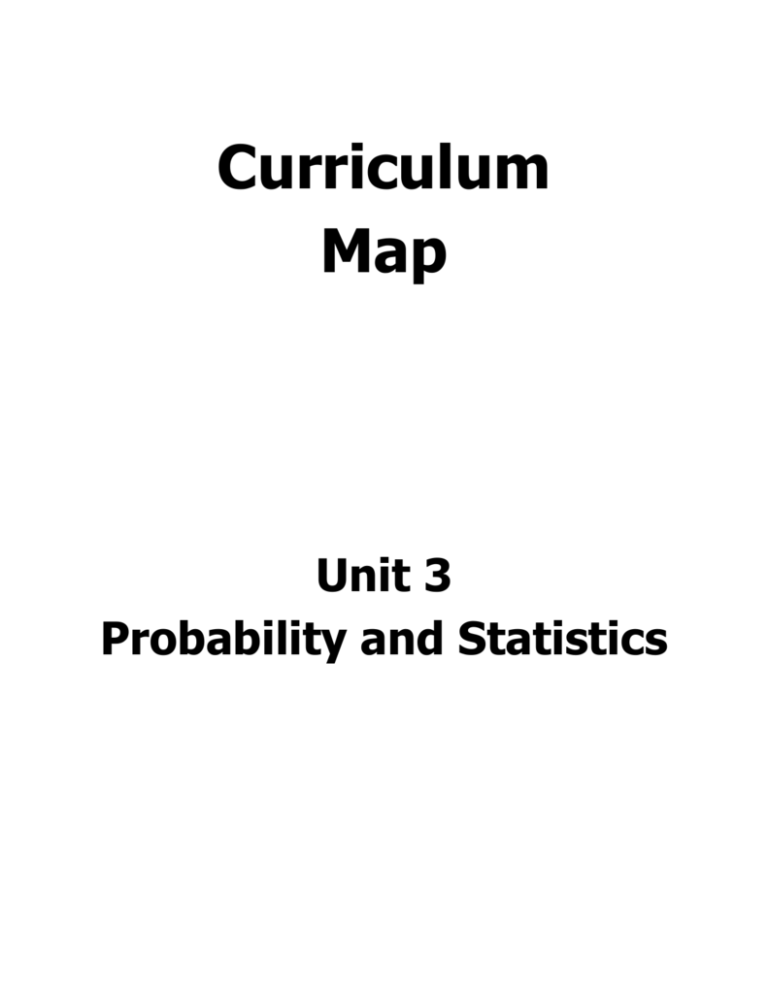
Curriculum Map Unit 3 Probability and Statistics Session 93 Wednesday, January 13, 2016 UEQs How does probability and statistics help us to better understand data? (Number of sessions: 16) Probability describes the likelihood of an event occuring while statistics can be used to draw conclusions about a population. Standards MAFS.7.SP.3.5 (view) (Number of sessions: 4) Content Complexity. Level 1: Recall Understand that the probability of a chance event is a number between 0 and 1 that expresses the likelihood of the event occurring. Larger numbers indicate greater likelihood. A probability near 0 indicates an unlikely event, a probability around 1/2 indicates an event that is neither unlikely nor likely, and a probability near 1 indicates a likely event. MAFS.7.SP.3.6 (view) (Number of sessions: 4) Content Complexity. Level 2: Basic Application of Skills & Concepts Approximate the probability of a chance event by collecting data on the chance process that produces it and observing its long-run relative frequency, and predict the approximate relative frequency given the probability. For example, when rolling a number cube 600 times, predict that a 3 or 6 would be rolled roughly 200 times, but probably not exactly 200 times. MAFS.7.SP.3.7 (view) (Number of sessions: 4) Content Complexity. Level 3: Strategic Thinking & Complex Reasoning Develop a probability model and use it to find probabilities of events. Compare probabilities from a model to observed frequencies; if the agreement is not good, explain possible sources of the discrepancy. Develop a uniform probability model by assigning equal probability to all outcomes, and use the model to determine probabilities of events. For example, if a student is selected at random from a class, find the probability that Jane will be selected and the probability that a girl will be selected. Develop a probability model (which may not be uniform) by observing frequencies in data generated from a chance process. For example, find the approximate probability that a spinning penny will land heads up or that a tossed paper cup will land open-end down. Do the outcomes for the spinning penny appear to be equally likely based on the observed frequencies? MAFS.K12.MP.1.1 (view) (Number of sessions: 4) Content Complexity. Level 3: Strategic Thinking & Complex Reasoning Make sense of problems and persevere in solving them. Mathematically proficient students start by explaining to themselves the meaning of a problem and looking for entry points to its solution. They analyze givens, constraints, relationships, and goals. They make conjectures about the form and meaning of the solution and plan a solution pathway rather than simply jumping into a solution attempt. They consider analogous problems, and try special cases and simpler forms of the original problem in order to gain insight into its solution. They monitor and evaluate their progress and change course if necessary. Older students might, depending on the context of the problem, transform algebraic expressions or change the viewing window on their graphing calculator to get the information they need. Mathematically proficient students can explain correspondences between equations, verbal descriptions, tables, and graphs or draw diagrams of important features and relationships, graph data, and search for regularity or trends. Younger students might rely on using concrete objects or pictures to help conceptualize and solve a problem. Mathematically proficient students check their answers to problems using a different method, and they continually ask themselves, Does this make sense? They can understand the approaches of others to solving complex problems and identify correspondences between different approaches. MAFS.K12.MP.3.1 (view) (Number of sessions: 4) Content Complexity. Level 3: Strategic Thinking & Complex Reasoning Construct viable arguments and critique the reasoning of others. Mathematically proficient students understand and use stated assumptions, definitions, and previously established results in constructing arguments. They make conjectures and build a logical progression of statements to explore the truth of their conjectures. They are able to analyze situations by breaking them into cases, and can recognize and use counterexamples. They justify their conclusions, communicate them to others, and respond to the arguments of others. They reason inductively about data, making plausible arguments that take into account the context from which the data arose. Mathematically proficient students are also able to compare the effectiveness of two plausible arguments, distinguish correct logic or reasoning from that which is flawed, and if there is a flaw in an argument explain what it is. Elementary students can construct arguments using concrete referents such as objects, drawings, diagrams, and actions. Such arguments can make sense and be correct, even though they are not generalized or made formal until later grades. Later, students learn to determine domains to which an argument applies. Students at all grades can listen or read the arguments of others, decide whether they make sense, and ask useful questions to clarify or improve the arguments. MAFS.K12.MP.4.1 (view) (Number of sessions: 4) Content Complexity. Level 3: Strategic Thinking & Complex Reasoning Model with mathematics. Mathematically proficient students can apply the mathematics they know to solve problems arising in everyday life, society, and the workplace. In early grades, this might be as simple as writing an addition equation to describe a situation. In middle grades, a student might apply proportional reasoning to plan a school event or analyze a problem in the community. By high school, a student might use geometry to solve a design problem or use a function to describe how one quantity of interest depends on another. Mathematically proficient students who can apply what they know are comfortable making assumptions and approximations to simplify a complicated situation, realizing that these may need revision later. They are able to identify important quantities in a practical situation and map their relationships using such tools as diagrams, two-way tables, graphs, flowcharts and formulas. They can analyze those relationships mathematically to draw conclusions. They routinely interpret their mathematical results in the context of the situation and reflect on whether the results make sense, possibly improving the model if it has not served its purpose. LAFS.7.SL.1.1 (view) (Number of sessions: 175) Content Complexity. Level 3: Strategic Thinking & Complex Reasoning Engage effectively in a range of collaborative discussions (one-on-one, in groups, and teacher-led) with diverse partners on grade 7 topics, texts, and issues, building on others ideas and expressing their own clearly. Come to discussions prepared, having read or researched material under study; explicitly draw on that preparation by referring to evidence on the topic, text, or issue to probe and reflect on ideas under discussion. Follow rules for collegial discussions, track progress toward specific goals and deadlines, and define individual roles as needed. Pose questions that elicit elaboration and respond to others questions and comments with relevant observations and ideas that bring the discussion back on topic as needed. Acknowledge new information expressed by others and, when warranted, modify their own views. LAFS.68.WHST.2.4 (view) (Number of sessions: 175) Content Complexity. Level 3: Strategic Thinking & Complex Reasoning Produce clear and coherent writing in which the development, organization, and style are appropriate to task, purpose, and audience. Learning Goals Know - (Number of sessions: 4) Probability expresses the likelihood of an event occuring. The larger the number the greater the likelihood. The smaller the number the less the likelihood. The probability of a chance event occuring can by approximated and predicted by collecting data on the change process and observing its long-run relative frequency. Do - (Number of sessions: 4) Approximate and predict the probability of a chance event occuring by collecting data on the chance event and observing its long-run relative frequency. Compare probabilities from a probability model to observed frequencies. Explain possible sources of discrepancies when the agreements are not good. LEQs How are the probabilities from a model to observed frequencies compared? (Number of sessions: 4) The probabilities from a probability model to the observed frequencies are compared by calculating the theoretical probability to the experimental probability. Resources Textbook - (Number of sessions: 4) Chapter 9 - Lesson 1 - p. 711 Chapter 9 - Inquiry Lab - p. 719 Chapter 9 - Lesson 2 - p. 721 Vocabulary Vocabulary - (Number of sessions: 4) Probability Outcome Simple Event Random Complementary Events Relative Frequency Uniform Probability Model Theoretical Probability Experimental Probability Session 97 Wednesday, January 20, 2016 UEQs How does probability and statistics help us to better understand data? (Number of sessions: 16) Probability describes the likelihood of an event occuring while statistics can be used to draw conclusions about a population. Standards MAFS.7.SP.3.8 (view) (Number of sessions: 5) Content Complexity. Level 3: Strategic Thinking & Complex Reasoning Find probabilities of compound events using organized lists, tables, tree diagrams, and simulation. Understand that, just as with simple events, the probability of a compound event is the fraction of outcomes in the sample space for which the compound event occurs. Represent sample spaces for compound events using methods such as organized lists, tables and tree diagrams. For an event described in everyday language (e.g., rolling double sixes ), identify the outcomes in the sample space which compose the event. Design and use a simulation to generate frequencies for compound events. For example, use random digits as a simulation tool to approximate the answer to the question: If 40% of donors have type A blood, what is the probability that it will take at least 4 donors to find one with type A blood? MAFS.K12.MP.1.1 (view) (Number of sessions: 5) Content Complexity. Level 3: Strategic Thinking & Complex Reasoning Make sense of problems and persevere in solving them. Mathematically proficient students start by explaining to themselves the meaning of a problem and looking for entry points to its solution. They analyze givens, constraints, relationships, and goals. They make conjectures about the form and meaning of the solution and plan a solution pathway rather than simply jumping into a solution attempt. They consider analogous problems, and try special cases and simpler forms of the original problem in order to gain insight into its solution. They monitor and evaluate their progress and change course if necessary. Older students might, depending on the context of the problem, transform algebraic expressions or change the viewing window on their graphing calculator to get the information they need. Mathematically proficient students can explain correspondences between equations, verbal descriptions, tables, and graphs or draw diagrams of important features and relationships, graph data, and search for regularity or trends. Younger students might rely on using concrete objects or pictures to help conceptualize and solve a problem. Mathematically proficient students check their answers to problems using a different method, and they continually ask themselves, Does this make sense? They can understand the approaches of others to solving complex problems and identify correspondences between different approaches. MAFS.K12.MP.3.1 (view) (Number of sessions: 5) Content Complexity. Level 3: Strategic Thinking & Complex Reasoning Construct viable arguments and critique the reasoning of others. Mathematically proficient students understand and use stated assumptions, definitions, and previously established results in constructing arguments. They make conjectures and build a logical progression of statements to explore the truth of their conjectures. They are able to analyze situations by breaking them into cases, and can recognize and use counterexamples. They justify their conclusions, communicate them to others, and respond to the arguments of others. They reason inductively about data, making plausible arguments that take into account the context from which the data arose. Mathematically proficient students are also able to compare the effectiveness of two plausible arguments, distinguish correct logic or reasoning from that which is flawed, and if there is a flaw in an argument explain what it is. Elementary students can construct arguments using concrete referents such as objects, drawings, diagrams, and actions. Such arguments can make sense and be correct, even though they are not generalized or made formal until later grades. Later, students learn to determine domains to which an argument applies. Students at all grades can listen or read the arguments of others, decide whether they make sense, and ask useful questions to clarify or improve the arguments. MAFS.K12.MP.4.1 (view) (Number of sessions: 5) Content Complexity. Level 3: Strategic Thinking & Complex Reasoning Model with mathematics. Mathematically proficient students can apply the mathematics they know to solve problems arising in everyday life, society, and the workplace. In early grades, this might be as simple as writing an addition equation to describe a situation. In middle grades, a student might apply proportional reasoning to plan a school event or analyze a problem in the community. By high school, a student might use geometry to solve a design problem or use a function to describe how one quantity of interest depends on another. Mathematically proficient students who can apply what they know are comfortable making assumptions and approximations to simplify a complicated situation, realizing that these may need revision later. They are able to identify important quantities in a practical situation and map their relationships using such tools as diagrams, two-way tables, graphs, flowcharts and formulas. They can analyze those relationships mathematically to draw conclusions. They routinely interpret their mathematical results in the context of the situation and reflect on whether the results make sense, possibly improving the model if it has not served its purpose. LAFS.68.WHST.1.1 (view) (Number of sessions: 5) Content Complexity. Level 3: Strategic Thinking & Complex Reasoning Write arguments focused on discipline-specific content. Introduce claim(s) about a topic or issue, acknowledge and distinguish the claim(s) from alternate or opposing claims, and organize the reasons and evidence logically. Support claim(s) with logical reasoning and relevant, accurate data and evidence that demonstrate an understanding of the topic or text, using credible sources. Use words, phrases, and clauses to create cohesion and clarify the relationships among claim(s), counterclaims, reasons, and evidence. Establish and maintain a formal style. Provide a concluding statement or section that follows from and supports the argument presented. LAFS.7.SL.1.1 (view) (Number of sessions: 175) Content Complexity. Level 3: Strategic Thinking & Complex Reasoning Engage effectively in a range of collaborative discussions (one-on-one, in groups, and teacher-led) with diverse partners on grade 7 topics, texts, and issues, building on others ideas and expressing their own clearly. Come to discussions prepared, having read or researched material under study; explicitly draw on that preparation by referring to evidence on the topic, text, or issue to probe and reflect on ideas under discussion. Follow rules for collegial discussions, track progress toward specific goals and deadlines, and define individual roles as needed. Pose questions that elicit elaboration and respond to others questions and comments with relevant observations and ideas that bring the discussion back on topic as needed. Acknowledge new information expressed by others and, when warranted, modify their own views. LAFS.68.WHST.2.4 (view) (Number of sessions: 175) Content Complexity. Level 3: Strategic Thinking & Complex Reasoning Produce clear and coherent writing in which the development, organization, and style are appropriate to task, purpose, and audience. Learning Goals Know - (Number of sessions: 5) The probabilities of compound events can be found using organized list, tables, tree diagrams, and simulations. The probability of a compound event is the fraction of outcomes in the sample space for which the compound even occurs. Do - (Number of sessions: 5) Calculate the probabilities of compound events using organized list, tables, tree diagrams, and simulations. Represent sample spaces for compound events using organized list, tables, and tree diagrams. Identify the outcomes in a sample space. Design and use a simulation to generate frequencies for compound events. LEQs How are the probabilities of compound events found using organized list, tables, tree diagrams, and simulations? (Number of sessions: 5) The probability of a compound event is found from an organized list, sample space, and tree diagram by calculating the ratio of the favorable outcomes to the possible outcomes. The probability of a compound event is found from a simulation by selecting a method that has the same number of possible outcomes as the theoretical probabilities of the event. Each outcome can represent a different result(?). The simulation can then be used in place of the actual event to generate the frequencies for the compound events. The ratio of the favorable outcome to the possible outcome would then be used to calculate the probability. Resources Textbook - (Number of sessions: 5) Chapter 9 - Lesson 3 - p. 733 Chapter 9 - Lesson 4 - p. 741 Chapter 9 - Lesson 5 - p. 757 Chapter 9 - Lesson 6 - p. 765 Chapter 9 - Lesson 7 - p. 775 Vocabulary Vocabulary - (Number of sessions: 5) Sample Space Tree Diagram Compound Event Simulations Fundamental Counting Principle Permutation Independent Events Dependent Events Session 102 Wednesday, January 27, 2016 UEQs How does probability and statistics help us to better understand data? (Number of sessions: 16) Probability describes the likelihood of an event occuring while statistics can be used to draw conclusions about a population. Standards MAFS.7.SP.1.1 (view) (Number of sessions: 3) Content Complexity. Level 2: Basic Application of Skills & Concepts Understand that statistics can be used to gain information about a population by examining a sample of the population; generalizations about a population from a sample are valid only if the sample is representative of that population. Understand that random sampling tends to produce representative samples and support valid inferences. MAFS.7.SP.1.2 (view) (Number of sessions: 3) Content Complexity. Level 3: Strategic Thinking & Complex Reasoning Use data from a random sample to draw inferences about a population with an unknown characteristic of interest. Generate multiple samples (or simulated samples) of the same size to gauge the variation in estimates or predictions. For example, estimate the mean word length in a book by randomly sampling words from the book; predict the winner of a school election based on randomly sampled survey data. Gauge how far off the estimate or prediction might be. MAFS.K12.MP.1.1 (view) (Number of sessions: 3) Content Complexity. Level 3: Strategic Thinking & Complex Reasoning Make sense of problems and persevere in solving them. Mathematically proficient students start by explaining to themselves the meaning of a problem and looking for entry points to its solution. They analyze givens, constraints, relationships, and goals. They make conjectures about the form and meaning of the solution and plan a solution pathway rather than simply jumping into a solution attempt. They consider analogous problems, and try special cases and simpler forms of the original problem in order to gain insight into its solution. They monitor and evaluate their progress and change course if necessary. Older students might, depending on the context of the problem, transform algebraic expressions or change the viewing window on their graphing calculator to get the information they need. Mathematically proficient students can explain correspondences between equations, verbal descriptions, tables, and graphs or draw diagrams of important features and relationships, graph data, and search for regularity or trends. Younger students might rely on using concrete objects or pictures to help conceptualize and solve a problem. Mathematically proficient students check their answers to problems using a different method, and they continually ask themselves, Does this make sense? They can understand the approaches of others to solving complex problems and identify correspondences between different approaches. MAFS.K12.MP.3.1 (view) (Number of sessions: 3) Content Complexity. Level 3: Strategic Thinking & Complex Reasoning Construct viable arguments and critique the reasoning of others. Mathematically proficient students understand and use stated assumptions, definitions, and previously established results in constructing arguments. They make conjectures and build a logical progression of statements to explore the truth of their conjectures. They are able to analyze situations by breaking them into cases, and can recognize and use counterexamples. They justify their conclusions, communicate them to others, and respond to the arguments of others. They reason inductively about data, making plausible arguments that take into account the context from which the data arose. Mathematically proficient students are also able to compare the effectiveness of two plausible arguments, distinguish correct logic or reasoning from that which is flawed, and if there is a flaw in an argument explain what it is. Elementary students can construct arguments using concrete referents such as objects, drawings, diagrams, and actions. Such arguments can make sense and be correct, even though they are not generalized or made formal until later grades. Later, students learn to determine domains to which an argument applies. Students at all grades can listen or read the arguments of others, decide whether they make sense, and ask useful questions to clarify or improve the arguments. MAFS.K12.MP.4.1 (view) (Number of sessions: 3) Content Complexity. Level 3: Strategic Thinking & Complex Reasoning Model with mathematics. Mathematically proficient students can apply the mathematics they know to solve problems arising in everyday life, society, and the workplace. In early grades, this might be as simple as writing an addition equation to describe a situation. In middle grades, a student might apply proportional reasoning to plan a school event or analyze a problem in the community. By high school, a student might use geometry to solve a design problem or use a function to describe how one quantity of interest depends on another. Mathematically proficient students who can apply what they know are comfortable making assumptions and approximations to simplify a complicated situation, realizing that these may need revision later. They are able to identify important quantities in a practical situation and map their relationships using such tools as diagrams, two-way tables, graphs, flowcharts and formulas. They can analyze those relationships mathematically to draw conclusions. They routinely interpret their mathematical results in the context of the situation and reflect on whether the results make sense, possibly improving the model if it has not served its purpose. LAFS.7.SL.1.1 (view) (Number of sessions: 175) Content Complexity. Level 3: Strategic Thinking & Complex Reasoning Engage effectively in a range of collaborative discussions (one-on-one, in groups, and teacher-led) with diverse partners on grade 7 topics, texts, and issues, building on others ideas and expressing their own clearly. Come to discussions prepared, having read or researched material under study; explicitly draw on that preparation by referring to evidence on the topic, text, or issue to probe and reflect on ideas under discussion. Follow rules for collegial discussions, track progress toward specific goals and deadlines, and define individual roles as needed. Pose questions that elicit elaboration and respond to others questions and comments with relevant observations and ideas that bring the discussion back on topic as needed. Acknowledge new information expressed by others and, when warranted, modify their own views. LAFS.68.WHST.2.4 (view) (Number of sessions: 175) Content Complexity. Level 3: Strategic Thinking & Complex Reasoning Produce clear and coherent writing in which the development, organization, and style are appropriate to task, purpose, and audience. Learning Goals Know - (Number of sessions: 3) Statistics can be used to gain information about a population by examining a sample of that population. Random sampling tends to produce representative samples and support valid inferences. Do - (Number of sessions: 3) Draw inferences about a population with an unknown characteristic of interest. Generate multiple samples of the same size to gauge the variation in estimates or predictions. LEQs How is random sampling used to draw inferences about a population? (Number of sessions: 3) Random sampling can be used to draw inferences about a population by producing generalizations that can be applied to the population as a whole provided that the samples were reasonable. Resources Textbook - (Number of sessions: 3) Chapter 10 - Lesson 1 - p. 793 Chapter 10 - Lesson 2 - p. 801 Chapter 10 - Inquiry Lab - p. 809 Chapter 10 - Lesson 3 p. 813 Vocabulary Vocabulary - (Number of sessions: 3) Statistics Survey Population Sample Unbiased Sample Simple Random Sample Systematic Random Sample Biased Sample Convenience Sample Voluntary Response Sample Session 105 Monday, February 01, 2016 UEQs How does probability and statistics help us to better understand data? (Number of sessions: 16) Probability describes the likelihood of an event occuring while statistics can be used to draw conclusions about a population. Standards MAFS.7.SP.2.3 (view) (Number of sessions: 2) Content Complexity. Level 2: Basic Application of Skills & Concepts Informally assess the degree of visual overlap of two numerical data distributions with similar variabilities, measuring the difference between the centers by expressing it as a multiple of a measure of variability. For example, the mean height of players on the basketball team is 10 cm greater than the mean height of players on the soccer team, about twice the variability (mean absolute deviation) on either team; on a dot plot, the separation between the two distributions of heights is noticeable. MAFS.7.SP.2.4 (view) (Number of sessions: 2) Content Complexity. Level 2: Basic Application of Skills & Concepts Use measures of center and measures of variability for numerical data from random samples to draw informal comparative inferences about two populations. For example, decide whether the words in a chapter of a seventh-grade science book are generally longer than the words in a chapter of a fourth-grade science book. MAFS.K12.MP.1.1 (view) (Number of sessions: 2) Content Complexity. Level 3: Strategic Thinking & Complex Reasoning Make sense of problems and persevere in solving them. Mathematically proficient students start by explaining to themselves the meaning of a problem and looking for entry points to its solution. They analyze givens, constraints, relationships, and goals. They make conjectures about the form and meaning of the solution and plan a solution pathway rather than simply jumping into a solution attempt. They consider analogous problems, and try special cases and simpler forms of the original problem in order to gain insight into its solution. They monitor and evaluate their progress and change course if necessary. Older students might, depending on the context of the problem, transform algebraic expressions or change the viewing window on their graphing calculator to get the information they need. Mathematically proficient students can explain correspondences between equations, verbal descriptions, tables, and graphs or draw diagrams of important features and relationships, graph data, and search for regularity or trends. Younger students might rely on using concrete objects or pictures to help conceptualize and solve a problem. Mathematically proficient students check their answers to problems using a different method, and they continually ask themselves, Does this make sense? They can understand the approaches of others to solving complex problems and identify correspondences between different approaches. MAFS.K12.MP.3.1 (view) (Number of sessions: 2) Content Complexity. Level 3: Strategic Thinking & Complex Reasoning Construct viable arguments and critique the reasoning of others. Mathematically proficient students understand and use stated assumptions, definitions, and previously established results in constructing arguments. They make conjectures and build a logical progression of statements to explore the truth of their conjectures. They are able to analyze situations by breaking them into cases, and can recognize and use counterexamples. They justify their conclusions, communicate them to others, and respond to the arguments of others. They reason inductively about data, making plausible arguments that take into account the context from which the data arose. Mathematically proficient students are also able to compare the effectiveness of two plausible arguments, distinguish correct logic or reasoning from that which is flawed, and if there is a flaw in an argument explain what it is. Elementary students can construct arguments using concrete referents such as objects, drawings, diagrams, and actions. Such arguments can make sense and be correct, even though they are not generalized or made formal until later grades. Later, students learn to determine domains to which an argument applies. Students at all grades can listen or read the arguments of others, decide whether they make sense, and ask useful questions to clarify or improve the arguments. MAFS.K12.MP.4.1 (view) (Number of sessions: 2) Content Complexity. Level 3: Strategic Thinking & Complex Reasoning Model with mathematics. Mathematically proficient students can apply the mathematics they know to solve problems arising in everyday life, society, and the workplace. In early grades, this might be as simple as writing an addition equation to describe a situation. In middle grades, a student might apply proportional reasoning to plan a school event or analyze a problem in the community. By high school, a student might use geometry to solve a design problem or use a function to describe how one quantity of interest depends on another. Mathematically proficient students who can apply what they know are comfortable making assumptions and approximations to simplify a complicated situation, realizing that these may need revision later. They are able to identify important quantities in a practical situation and map their relationships using such tools as diagrams, two-way tables, graphs, flowcharts and formulas. They can analyze those relationships mathematically to draw conclusions. They routinely interpret their mathematical results in the context of the situation and reflect on whether the results make sense, possibly improving the model if it has not served its purpose. MAFS.K12.MP.5.1 (view) (Number of sessions: 2) Content Complexity. Level 2: Basic Application of Skills & Concepts Use appropriate tools strategically. Mathematically proficient students consider the available tools when solving a mathematical problem. These tools might include pencil and paper, concrete models, a ruler, a protractor, a calculator, a spreadsheet, a computer algebra system, a statistical package, or dynamic geometry software. Proficient students are sufficiently familiar with tools appropriate for their grade or course to make sound decisions about when each of these tools might be helpful, recognizing both the insight to be gained and their limitations. For example, mathematically proficient high school students analyze graphs of functions and solutions generated using a graphing calculator. They detect possible errors by strategically using estimation and other mathematical knowledge. When making mathematical models, they know that technology can enable them to visualize the results of varying assumptions, explore consequences, and compare predictions with data. Mathematically proficient students at various grade levels are able to identify relevant external mathematical resources, such as digital content located on a website, and use them to pose or solve problems. They are able to use technological tools to explore and deepen their understanding of concepts. LAFS.68.RST.3.7 (view) (Number of sessions: 2) Content Complexity. Level 3: Strategic Thinking & Complex Reasoning Integrate quantitative or technical information expressed in words in a text with a version of that information expressed visually (e.g., in a flowchart, diagram, model, graph, or table). LAFS.68.WHST.1.1 (view) (Number of sessions: 2) Content Complexity. Level 3: Strategic Thinking & Complex Reasoning Write arguments focused on discipline-specific content. Introduce claim(s) about a topic or issue, acknowledge and distinguish the claim(s) from alternate or opposing claims, and organize the reasons and evidence logically. Support claim(s) with logical reasoning and relevant, accurate data and evidence that demonstrate an understanding of the topic or text, using credible sources. Use words, phrases, and clauses to create cohesion and clarify the relationships among claim(s), counterclaims, reasons, and evidence. Establish and maintain a formal style. Provide a concluding statement or section that follows from and supports the argument presented. LAFS.7.SL.1.2 (view) (Number of sessions: 2) Content Complexity. Level 2: Basic Application of Skills & Concepts Analyze the main ideas and supporting details presented in diverse media and formats (e.g., visually, quantitatively, orally) and explain how the ideas clarify a topic, text, or issue under study. LAFS.7.SL.1.1 (view) (Number of sessions: 175) Content Complexity. Level 3: Strategic Thinking & Complex Reasoning Engage effectively in a range of collaborative discussions (one-on-one, in groups, and teacher-led) with diverse partners on grade 7 topics, texts, and issues, building on others ideas and expressing their own clearly. Come to discussions prepared, having read or researched material under study; explicitly draw on that preparation by referring to evidence on the topic, text, or issue to probe and reflect on ideas under discussion. Follow rules for collegial discussions, track progress toward specific goals and deadlines, and define individual roles as needed. Pose questions that elicit elaboration and respond to others questions and comments with relevant observations and ideas that bring the discussion back on topic as needed. Acknowledge new information expressed by others and, when warranted, modify their own views. LAFS.68.WHST.2.4 (view) (Number of sessions: 175) Content Complexity. Level 3: Strategic Thinking & Complex Reasoning Produce clear and coherent writing in which the development, organization, and style are appropriate to task, purpose, and audience. Learning Goals Do - (Number of sessions: 2) Informally assess the degree of visual overlap of two numerical data distributions with similar variabilites. Use measures of center and measures of variability for numerical data from random samples to draw information comparative inferences about two populations. Know - (Number of sessions: 2) The most appropriate measure for comparing data sets depends on the symmetry of the two data sets. LEQs How are informal comparative inferences about two populations drawn? (Number of sessions: 2) Informal comparative inferences about two populations are drawn by comparing the measures of center and the measures of variation of the two sets. The appropriate measures of center and measures of variation are determined based on the symmetry of the data sets. Resources Textbooks - (Number of sessions: 2) Chapter 10 - Lesson 4 - p. 827 Chapter 10 - Lesson 5 - p. 839 Vocabulary Vocabulary - (Number of sessions: 2) Double Box Plot Double Dot Plot Unit Plan Unit 3 Probability and Statistics Unit 3-Probability and Statistics Date Range: Jan 13-Feb 4 Unit Essential Question: How does probability and statistics help us to better understand data? Lesson Essential Question 1 Jan 13-19 How are the probabilities from a model compared to observed frequencies? Lesson Essential Question 2 Jan 20-26 Lesson 1 Vocabulary Probability Outcome Simple Event Random Complementary Events Relative Frequency Uniform Probability Model Theoretical Probability Experimental Probability Lesson 2 Vocabulary How are the probabilities of compound events found using organized lists, tables, tree diagrams, and simulations? Sample Space Tree Diagram Compound Event Simulations Fundamental Counting Principle Permutations Independent Events Dependent Events Lesson Essential Question 3 Lesson 3 Vocabulary Jan 27-29 How is random sampling used to draw inferences about a population? Statistics Survey Population Sample Unbiased Sample Simple Random Sample Systematic Random Sample Biased Sample Convenience Sample Voluntary Response Sample Lesson Essential Question 4 Lesson 4 Vocabulary Feb 1-2 Double Box Plot Double Dot Plot Mean Absolute Deviation How are informal comparative inferences about two populations drawn? Major Unit Assignment and Formative Assessment Feb 3-4 21st Century Career – Keeping Your Eye on the Target Market – p. 848 Students will combine their knowledge of probability and their understanding of statistics to analyze data. Keeping Your Eye on the Target Market Glencoe Textbook, Course 2 – page 848 Questions 1. 0 pts The answer is incorrect. 2. The answer is incorrect. 3. The answer is incorrect. 4. The answer is incorrect. 5. The answer is incorrect. Total Points Possible: 6 points 1 pt The correct answer is given. The correct answer is given. The correct answer is given. A correct probability is given but not percent form. The correct answer is given. 2 pts The correct answer is given. Percentage Correct: _____________________ Lesson Plans Unit 3 Probability and Statistics Simple Probability Unit 3 – Lesson 1 8 days Learning Goals for this Lesson: Standards: MAFS.7.SP.3.5, MAFS.7.SP.3.6, MAFS.7.SP.3.7 MAFS.K12.MP.1.1, MAFS.K12.MP.3.1, MAFS.K12.MP.4.1, LAFS.68.WHST.2.4, LAFS.7.SL.1.1 Students Will Know: Students Will Be Able To: Probability expresses the likelihood of an event occurring. The larger the number the greater the likelihood. The smaller the number the less the likelihood. The probability of a chance event occurring can be approximated and predicted by collecting data on the change process and observing its long run relative frequency. Approximate and predict the probability of a chance event occurring by collecting data on the chance event and observing its long run relative frequency. Compare probabilities from a probability model to observed frequencies. Explain possible sources of discrepancies when the agreements are not good. Lesson Essential Question: How are the probabilities from a model compared to observed frequencies? Activating Strategy: Math Genes – Course 2, Volume 2 – p. 706. Students will complete a Punnett Square on Pea Plants to determine the percent of outcomes that will be short in the offspring. (Video Option.) Key Vocabulary to Preview and Vocabulary Strategy: Probability Outcome Simple Event Random Uniform Probability Model Theoretical Probability Complementary Events Experimental Probability Lesson Instruction: Learning Activity 1: Use the Cornell Note format to take notes on the key vocabulary. (Preview of the vocabulary.) Relative Frequency Graphic Organizer: Frayer Cornell Notes Assessment Prompt for LA 1: Have students create Frayer Models for the new vocabulary words. WritePair-Share. Differentiation for LA 1: Ability Levels: Paired Groupings (stronger/slightly weaker students) Learning Styles: Visual, Auditory, Interpersonal, Intrapersonal, Kinetic Varied Interest: Students will be allowed to choose 2 of the new vocabulary words to create a Frayer Model. *** See the document at the end of the unit for more information. Learning Activity 2: Discuss the error points and model problems involving probability. After each example, students complete the “Got It?” questions with their partners. (InkPair-Share.) Probability can be expressed as a fraction, percent, or a decimal. Assignment: Textbook p. 729-730 Q 1-6 Fair and Unfair Games In this activity, students will Complementary Events are added together. Theoretical Probability is when you are “looking/thinking” at the object. Experimental Probability is when the experiment has actually been done. Have students complete a probability experiment in which they calculate the probability of a spinner landing on red, blue, green, and yellow after 10 trials, 25 trials, 50 trials, and a combined classroom of trials. Have students compare their experimental probabilities to the theoretical probabilities and discuss possible reasons for discrepancies. Assessment Prompt for LA 2: Question: How are Experimental Probability and Theoretical Probability alike and different? As tell the Bs their answer and give their reasoning. Bs follow up – do you agree, disagree, or need to add to? Call on bs to answer aloud for the class. Differentiation for LA 2: Ability Levels: Paired Groupings (stronger/slightly weaker students) Learning Styles: Visual, Auditory, Interpersonal, Intrapersonal, Kinetic *** See the document at the end of the unit for more information. Learning Activity 3: Review how to use Marking the Text with students using a problem involving probability. Provide students with an additional word problem (probability) to solve. (Ink-Pair-Share) Assessment Prompt for LA 3: Complete word problems pertaining to the LEQ using the Marking the Text Strategy with their partners. Differentiation for LA 3: Ability Levels: Paired Groupings (stronger/slightly weaker students) Learning Styles: Interpersonal, Intrapersonal, and Kinetic Varied Interest: Create and solve their own word problem. *** See the document at the end of the unit for more information. Learning Activity 4: Review how to solve word problem involving a H.O.T. skill that involve probabiltiy. Remind students to use the Marking the Text strategy. Provide students with an additional H.O.T. problem to solve. (Ink-Pair-Share) Assessment Prompt for LA 4: Complete H.O.T problems pertaining to the LEQ using the Marking the Text Strategy with their partners. Differentiation for LA 4: Ability Levels: Paired Groupings (stronger/slightly weaker students) Learning Styles: Visual, Auditory, Interpersonal, Intrapersonal, Kinetic Varied Interest: Choose two of the H.O.T questions from the textbook related content. *** See the document at the end of the unit for more information. determine the fairness of a game by using understanding of probability. Summarizing Strategy: Students will review their Cornell Notes to answer the LEQ in the Summary section. Student Reflections: Modification/Accommodations 1. Seat student near teacher. 2. Stand near student when giving directions/presenting. 3. Provide visual aids/graphic organizers. 4. Ensure oral directions are understood. 5. Allow extra time to complete tasks. 6. Simplify complex written directions. 7. Give test items orally. 8. Provide peer assistance/study groups. Compound Probability Unit 3 – Lesson 2 10 days Learning Goals for this Lesson: Standards: MAFS.7.SP.3.8 MAFS.K12.MP.1.1, MAFS.K12.MP.3.1, MAFS.K12.MP.4.1, LAFS.68.WHST.2.4, LAFS.7.SL.1.1, LAFS.68.WHST.1.1 Students Will Know: Students Will Be Able To: The probabilities of compound events can be found using organized lists, tables, tree diagrams, and simulations. The probability of a compound even is the fraction of outcomes in the sample space for which the compound event occurs. Calculate the probabilities of compound events using organized lists, tables, tree diagrams, and simulations. Represent sample spaces for compound events using organized lists, tables, and tree diagrams. Identify the outcomes and the sample space. Design and use a simulation to generate frequencies for compound events. Lesson Essential Question: How are the probabilities of compound events found using organized lists, tables, tree diagrams, and simulations? Activating Strategy: Real-World Link - Travel - Text, Course 2 – p. 733 Students will explore compound events through a question about possible outfit combinations. Key Vocabulary to Preview and Vocabulary Strategy: Sample Space Permutations Tree Diagram Compound Event Simulations Independent Events Dependent Events Fundamental Counting Principle Lesson Instruction: Learning Activity 1: Use the Cornell Note format to take notes on the key vocabulary. (Preview of the vocabulary.) Graphic Organizer: Frayer Model Cornell Notes Assessment Prompt for LA 1: Have students create a Frayer Model for the new vocabulary word. WritePair-Share. Differentiation for LA 1: Ability Levels: Paired Groupings (stronger/slightly weaker students) Learning Styles: Visual, Auditory, Interpersonal, Intrapersonal, Kinetic Varied Interest: Students will be allowed to choose 2 of the new vocabulary words to create a Frayer Model. *** See the document at the end of the unit for more information. Learning Activity 2: Discuss the error points and model problems involving compound probability. Be sure to point out/review: In permuations such as P(12, 2) – the first value tells you what to start with and the second value tells you the number of factors. Independent Events and Dependent Events are always multiplied. Assignment: Textbook p. 787 Carnival Prizes In this activity, students will create a sample space and determine the probability of winning a game at the After each example section, students complete the “Got It?” questions with their partners. (Ink-Pair-Share.) Assessment Prompt for LA 2: carnival. Rubric – page PT5. Question: Explain the difference between independent and dependent events. Bs tell the As their answer and give their reasoning. As follow up – do you agree, disagree, or need to add to? Call on As to answer aloud for the class. Differentiation for LA 2: Ability Levels: Paired Groupings (stronger/slightly weaker students) Learning Styles: Visual, Auditory, Interpersonal, Intrapersonal, Kinetic *** See the document at the end of the unit for more information. Learning Activity 3: Review how to use Marking the Text with students using a problem involving equations. Provide students with an additional word problem (drawing geometric figures) to solve. (Ink-Pair-Share) Assessment Prompt for LA 3: Complete word problems pertaining to the LEQ using the Marking the Text Strategy with their partners. Differentiation for LA 3: Ability Levels: Paired Groupings (stronger/slightly weaker students) Learning Styles: Interpersonal, Intrapersonal, and Kinetic Varied Interest: Create and solve their own word problem. *** See the document at the end of the unit for more information. Learning Activity 4: Review how to solve word problem involving a H.O.T. skill that involve equations. Remind students to use the Marking the Text strategy. Provide students with an additional H.O.T. problem to solve. (Ink-Pair-Share) Assessment Prompt for LA 4: Complete H.O.T problems pertaining to the LEQ using the Marking the Text Strategy with their partners. Differentiation for LA 4: Ability Levels: Paired Groupings (stronger/slightly weaker students) Learning Styles: Visual, Auditory, Interpersonal, Intrapersonal, Kinetic Varied Interest: Choose two of the H.O.T questions from the textbook related content. *** See the document at the end of the unit for more information. Summarizing Strategy: Students will review their Cornell Notes to answer the LEQ in the Summary section. Student Modification/Accommodations 1. Seat student near teacher. 2. Stand near student when giving directions/presenting. 3. Provide visual aids/graphic organizers. 4. Ensure oral directions are understood. 5. Allow extra time to complete tasks. 6. Simplify complex written directions. 7. Give test items orally. 8. Provide peer assistance/study groups. Random Sampling Unit 3 – Lesson 3 6 Days Learning Goals for this Lesson: Standards: MAFS.7.SP.1.1, MAFS.7.SP.1.2 MAFS.K12.MP.1.1, MAFS.K12.MP.3.1, MAFS.K12.MP.4.1, LAFS.68.WHST.2.4, LAFS.7.SL.1.1 Students Will Know: Students Will Be Able To: Statistics can be used to gain information about a population by examining a sample of that population. Random sampling tends to produce representative samples and support valid inferences. Draw inferences about a population with an unknown characteristic of interest. Generate multiple samples of the same size to gauge the variation in estimates or predictions. Lesson Essential Question: How is random sampling used to draw inferences about a population? Activating Strategy: Real-World Link – Vocabulary Start-Up - Text p. 793, Course 2, Volume 2 – Students will determine whether a set of data represents a sample or a population. Key Vocabulary to Preview and Vocabulary Strategy: Statistics Survey Population Sample Unbiased Sample Simple Random Sample Systematic Random Sample Biased Sample Convenience Sample Voluntary Response Sample Lesson Instruction: Learning Activity 1: Use the Cornell Note format to take notes on the key vocabulary. Assessment Prompt for LA 1: Graphic Organizer: Attached Organizer Cornell Notes Have students create a Frayer Model for the new vocabulary word. WritePair-Share. Differentiation for LA 1: Ability Levels: Paired Groupings (stronger/slightly weaker students) Learning Styles: Visual, Auditory, Interpersonal, Intrapersonal, Kinetic Varied Interest: Students will be allowed to choose 2 of the new vocabulary words to create a Frayer Model. *** See the document at the end of the unit for more information. Learning Activity 2: Discuss the error points and model problems involving cross sections with students. Be sure to point out/review: Assignment: Softball: Text p. 808 Q 18 Students are asked to determine the After each example, students complete the “Got It?” questions with their partners. (Ink-Pair-Share.) Assessment Prompt for LA 2: Question: “What can cause data to be misleading? Explain.” Bs tell the As their answer and give their reasoning. A s follow up – do you agree, disagree, or need to add to? Call on As to answer aloud for the class. Differentiation for LA 2: Ability Levels: Paired Groupings (stronger/slightly weaker students) Learning Styles: Visual, Auditory, Interpersonal, Intrapersonal, Kinetic *** See the document at the end of the unit for more information. Learning Activity 3: Review how to use Marking the Text with students using a problem involving random samples. Provide students with an additional word problem to solve. (Ink-Pair-Share) Assessment Prompt for LA 3: Have students create a Frayer Model for the new vocabulary word. WritePair-Share. Differentiation for LA 3: Ability Levels: Paired Groupings (stronger/slightly weaker students) Learning Styles: Interpersonal, Intrapersonal, and Kinetic Varied Interest: Create and solve their own word problem. *** See the document at the end of the unit for more information. Learning Activity 4: Review how to solve cross section word problem involving a H.O.T. skill. Remind students to use the Marking the Text strategy. Provide students with an additional H.O.T. problem to solve. (Ink-Pair-Share) Assessment Prompt for LA 4: Complete H.O.T problems pertaining to the LEQ using the Marking the Text Strategy with their partners. Differentiation for LA 4: Ability Levels: Paired Groupings (stronger/slightly weaker students) Learning Styles: Visual, Auditory, Interpersonal, Intrapersonal, Kinetic Varied Interest: Choose two of the H.O.T questions from the textbook related content. *** See the document at the end of the unit for more information. Summarizing Strategy: Answer the LEQ in the Summary section of their Cornell Notes. validity of a conclusion and suggestion possible changes in the survey to achieve a more valid conclusion. Student Modification/Accommodations 1. Seat student near teacher. 2. Stand near student when giving directions/presenting. 3. Provide visual aids/graphic organizers. 4. Ensure oral directions are understood. 5. Allow extra time to complete tasks. 6. Simplify complex written directions. 7. Give test items orally. 8. Provide peer assistance/study groups. Comparing Populations Unit 3 – Lesson 4 5 days Learning Goals for this Lesson: Standards: MAFS.7.SP.2.3., MAFS.7.SP.2.4 MAFS.K12.MP.1.1, MAFS.K12.MP.3.1, MAFS.K12.MP.4.1, MAFS.K12.MP.5.1 LAFS.68.WHST.1.1, LAFS.7.SL.1.1, LAFS.7.SL.1.2, LAFS.68. RST.3.7 Students Will Know: Students Will Be Able To: The most appropriate measure for comparing data sets depends on the symmetry of the data sets. Informally assess the degree of visual overlap of two numerical data distributions with similar variabilities. Use measures of center and measures of variability for numerical data from random samples to draw informal comparative inferences about two populations. Lesson Essential Question: How are informal comparative inferences about two populations drawn? Activating Strategy: Real-World Link p. 827 - Exercise – Students will identify the components of a box plot Key Vocabulary to Preview and Vocabulary Strategy: Double Box Plot Double Dot Plot Lesson Instruction: Learning Activity 1: Use the Cornell Note format to take notes on the key vocabulary. (Preview of the vocabulary.) Graphic Organizer: Frayer Cornell Notes Assessment Prompt for LA 1: Question: “What is the relationship between Pi, Circumference, and Diameter? Explain.” As tell the Bs their answer and give their reasoning. Bs follow up – do you agree, disagree, or need to add to? Call on Bs to answer aloud for the class. Differentiation for LA 1: Ability Levels: Paired Groupings (stronger/slightly weaker students) Learning Styles: Visual, Auditory, Interpersonal, Intrapersonal, Kinetic Varied Interest: Students will be allowed to choose 2 of the new vocabulary words to create a Frayer Model. *** See the document at the end of the unit for more information. Learning Activity 2: Discuss the error points and model problems involving angle relationships. After each example, students complete the “Got It?” questions with their partners. (Ink-Pair-Share.) R2 is NOT r x 2 Circumference answers are NOT squared. Assignment: Textbook p. 851 Performance Task – Class Evaluation Students are asked to analyze the data Assessment Prompt for LA 2: from a random sampling of 3 years worth of student grades. Text p. 832 Q 3 Differentiation for LA 2: Rubric – PT6 Ability Levels: Paired Groupings (stronger/slightly weaker students) Learning Styles: Visual, Auditory, Interpersonal, Intrapersonal, Kinetic *** See the document at the end of the unit for more information. Learning Activity 3: Review how to use Marking the Text with students using a problem involving circumference and area. Provide students with an additional word problem to solve. (Ink-Pair-Share) Assessment Prompt for LA 3: Complete word problems pertaining to the LEQ using the Marking the Text Strategy with their partners. Differentiation for LA 3: Ability Levels: Paired Groupings (stronger/slightly weaker students) Learning Styles: Interpersonal, Intrapersonal, and Kinetic Varied Interest: Create and solve their own word problem. *** See the document at the end of the unit for more information. Learning Activity 4: Review how to solve word problem involving a H.O.T. skill that involve angle relationships. Remind students to use the Marking the Text strategy. Provide students with an additional H.O.T. problem to solve. (Ink-Pair-Share) Assessment Prompt for LA 4: Complete H.O.T problems pertaining to the LEQ using the Marking the Text Strategy with their partners. Differentiation for LA 4: Ability Levels: Paired Groupings (stronger/slightly weaker students) Learning Styles: Visual, Auditory, Interpersonal, Intrapersonal, Kinetic Varied Interest: Choose two of the H.O.T questions from the textbook related content. *** See the document at the end of the unit for more information. Summarizing Strategy: Students will review their Cornell Notes to answer the LEQ in the Summary section. Student Modification/Accommodations 1. Seat student near teacher. 2. Stand near student when giving directions/presenting. 3. Provide visual aids/graphic organizers. 4. Ensure oral directions are understood. 5. Allow extra time to complete tasks. 6. Simplify complex written directions. 7. Give test items orally. 8. Provide peer assistance/study groups. Differentiation throughout the Unit: Ability Levels: Getting Started/Moving Forward Students: Students will generally need additional practice on the computation portion of the lessons. This can be achieved through Wednesday tutoring sessions, SuccessMaker time, and additional computation problems being assigned. “Getting Started/Moving Forward” students will also be paired up with “Almost There/Got It” partners (not too large of a gap) to work in a mutually beneficial collaborative pair. Giving the “Getting Started/Moving Forward” student the advantage of hearing the “Almost There/Got It” student’s logic and reasoning, as well as receiving addition help in solving problems. Almost There/Got It Students: Students will generally to spend less time on the computation portion of the lesson and more time on the higher order thinking portion of the lesson. This can be adjusted based on the need of the class or individual student. “Almost There/Got It” students will also be paired up with “Getting Started/Moving Forward” partners (not too large of a gap) to work in a mutually beneficial collaborative pair. Giving the “Almost There/Got It” student the ability to really solidify their knowledge and understanding by communicating the concepts to their peers as well as serving as a tutor. *** Student categories should be constantly changing as student strengths and weakness will most likely vary by topic. Learning Styles: Visual: The lessons will be taught through the use of a projector system that allows the teacher to present the lesson to the students in an array of visual effects. (Display of notes, highlight key concepts/words, color-code notes, create graphic organizers, etc.) Auditory: The lessons will delivered orally in conjunctions with the visual style. Interpersonal: Each lesson provides students with the opportunity work collaboratively with their peers through think-pair-share activities, etc. Intrapersonal: Each lesson provides students with the opportunity to work out problems individually. Kinetic: Throughout the unit, students will have the opportunity to create graphic organizers, work with manipulatives, and demonstrate problem solving. Varied Interest: Throughout the course of the unit students are given an opportunity to create their own problems to solve. Students are asked to create and solve their own problems when their group quickly grasps a concept and finishes an assignment early or does not need additional class practice. Students are encouraged to create problems, when applicable, that have real-life meaning to them. Finished? Students that finish assignments early will have the opportunity to choose an additional task that relates to the lesson. Students can choose to write a test question, work on additional problems with a partner, write-solve-switch their own problems with a partner, write a detailed description of how to solve a problem, create a frayer, or link the current concept to a previous concept through writing.
